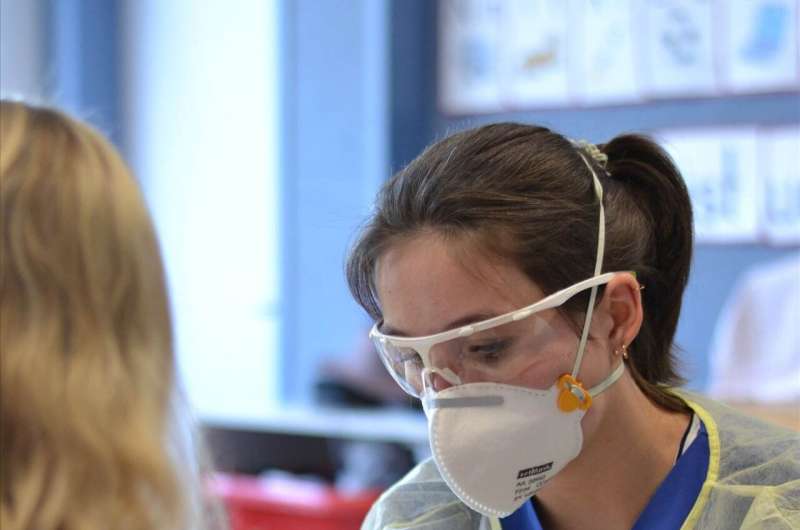Research team determines COVID-19 infection fatality rate

The district of Heinsberg in the German state of North Rhine-Westphalia is considered a hot spot for the novel Coronavirus SARS-CoV-2. Following a carnival celebration, the district became one of the first areas in Germany where the pathogen spread and infected large numbers of people. As part of the study, a research team led by Prof. Dr. Hendrik Streeck and Prof. Dr. Gunther Hartmann from the University of Bonn carried out a large study to determine the infection fatality rate precisely for the first time, among other findings. The results of the study have been pre-published, and publication in a peer-reviewed journal is to follow.
The focus of the study is the infection fatality rate (IFR), which indicates the ratio of deaths in comparison to those infected. The IFR is different to the case fatality rate (CFR). For various reasons, the IFR is considered the more reliable parameter and there is an international demand to have a more accurate understanding of the fatality of SARS-CoV2. "For the first time, our data enables us to estimate how many people have been infected after the superspreading event. Approximately 15 percent of Gangelt had been infected. The total number of infections allows us to determine the infection fatality rate. In Gangelt, the IFR after the SARS-CoV-2 outbreak is 0.37 percent," says lead investigator Prof. Dr. Hendrik Streeck, Director of the Institute for Virology at the University Hospital Bonn.
Based on the IFR and the number of deaths, estimations about the total number of infections in similar demographic areas with different infection rates can be made. Comparing this number with the number of officially reported infections leads to an estimate of unreported cases. In Gangelt, this figure is about 5 times higher than the official number of people tested positively. With an extrapolation based on 6,700 SARS-CoV-2 associated deaths in Germany, a total of 1.8 million infections can be assumed. This number of unreported cases is about 10 times higher than the officially reported cases (162,496 on May 3rd, 2020).
"The results can be used to further improve models on the transmission behavior of the virus. Until now, basis for such data has been relatively uncertain," says co-author Prof. Dr. Gunther Hartmann, Director of the Institute for Clinical Chemistry and Clinical Pharmacology at the University Hospital Bonn and speaker of the Cluster of Excellence, ImmunoSensation. The study also provides important indicators for further research on SARS-CoV-2 such as: the infection risk dependent on age, gender and pre-existing conditions; the increased severity of illness amidst special circumstances of a massive infection incident such as in Gangelt, or on the risk of infection within families.
20% of COVID-19 infections are asymptomatic
The description of symptoms is another aspect the study covers. Loss of smell and taste, as previously identified by Prof. Streeck, are the most striking symptoms for this infection. Interestingly, 22 percent of infected persons in Gangelt were asymptomatic. People who participated in the carnival event had more often symptoms. "In order to examine if physical proximity to participants of the carnival event and the increased aerosol formation through loud speaking or singing lead to a more severe disease progression, we are planning further studies in cooperation with hygiene specialists," explains Prof. Hartmann.
"Apparently, one in five infections occurs without noticeable symptoms, suggesting that infected persons who secrete virus and can infect others cannot be reliably identified on the basis of recognizable symptoms of the disease," says Prof. Dr. Martin Exner, head of the Institute for Hygiene and Public Health and co-author of the study. This confirms the importance of general rules of distance and hygiene in the corona pandemic. "Every supposedly healthy person we encounter can unknowingly carry the virus. We must be aware of this and act accordingly," says the hygiene expert.
Studies of multi-person households showed that the risk of infecting another person was surprisingly low. "The infection rate in children, adults and elderly is very similar and is apparently not dependent on age," says Prof. Streeck. There are also no significant differences between genders.
A total of 919 participants from 405 households
A total of 600 randomly selected households in Gangelt were written to and asked to participate in the study. 919 study participants from 405 households were interviewed and tested between March 30th and April 6th, six weeks after the outbreak of the infection. Researchers took throat swabs and performed blood tests. In the acute phase of the infection in the first one or two weeks, the PCR test, which captures the genetic thumbprint of SARS-CoV-2, is very reliable. Two or three weeks after the infection takes place, the immune system builds antibody responses against the virus, which can be detected by ELISA.
"By combining PCR and ELISA tests we are able to detect acute as well as elapsed infections," says Prof. Hartmann. Preliminary studies showed that the ELISA test is false positive in about one percent of the cases. "However, with such high frequency of infections in Gangelt, a one percent false positive rate is not critical," Hartmann explains. For studies planned to take place across Germany with an estimated infection rate of approximately one to two percent a one percent false positive rate pose rather a problem.
"Which conclusions can be drawn from the study results depends on many factors that go beyond pure scientific considerations," says Prof. Streeck. "The evaluation of our findings and their impact on concrete decisions are the responsibility of society and politics."
In the SARS-CoV-2 pandemic, exceptional rules also apply for scientific publishing. Renowned scientific journals require that papers on the topic of COVID-19 are first uploaded to a preprint server and thus made available immediately to science and health authorities (see https://wellcome.ac.uk/coronavirus-COVID-19/open-data. Following this step, the normal publication process by peer review takes place.




















